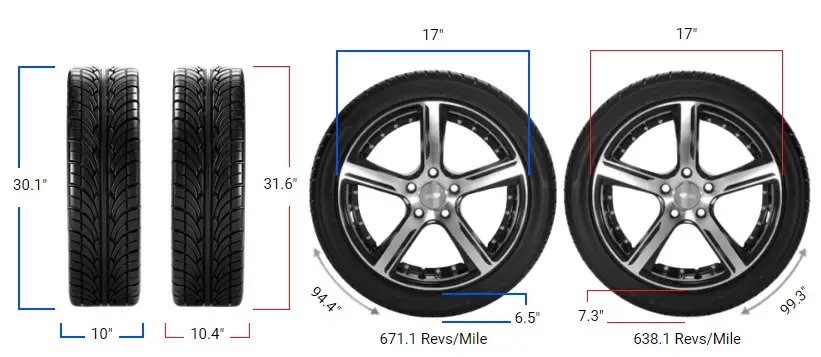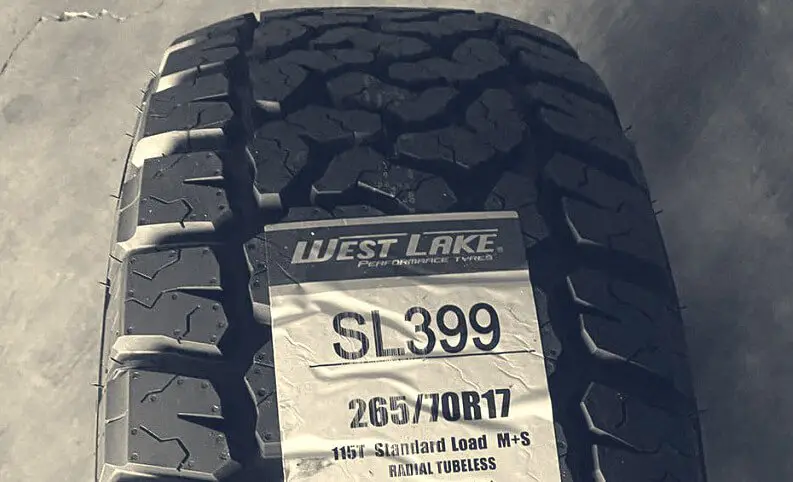Tire Size 255/65r17 vs 265/70r17

Are you considering switching from 255/65R17 to 265/70R17 tires? While this change may seem minor, it can have a significant impact on your vehicle’s performance and handling. We’ll explore the key differences between these tire sizes and help you make an informed decision.
- The overall diameter of 265/70R17 tires is 5.2% larger than 255/65R17 tires
- The width of 265/70R17 tires is 3.9% wider than 255/65R17 tires
- The sidewall height of 265/70R17 tires is 11.9% taller than 255/65R17 tires
- The speedometer will read 1.03 mph slower than the actual speed at 20 mph
255/65r17 vs 265/70r17 Table
The main difference between 255/65R17 and 265/70R17 tires lies in their overall diameter. The 265/70R17 tires have a diameter that is 1.56 inches (39.5 mm) larger, which equates to a 5.2% increase.

Fitment Guide
As the diameter difference between 255/65R17 and 265/70R17 tires exceeds the acceptable 3% range, the interchange is not recommended without proper adaptations.
Failing to make necessary adjustments can lead to rubbing or clearance problems, potentially causing damage to your vehicle or compromising its performance.
On-Road Impact
Switching to 265/70R17 tires can have several effects on your vehicle’s on-road performance. Here are some key aspects to consider:
- Ground Clearance: The taller sidewall of the 265/70R17 tires will increase your vehicle’s ground clearance, which can be beneficial for navigating rough roads or mild off-road conditions. However, this may also affect the vehicle’s center of gravity and handling characteristics.
- Gas Mileage: The larger size and increased weight of the 265/70R17 tires may slightly reduce your vehicle’s gas mileage. The extent of this impact depends on factors such as driving habits and vehicle type.
- Ride Comfort: The taller sidewall of the 265/70R17 tires can provide a more cushioned ride, absorbing bumps and vibrations more effectively. However, this may also result in a slightly less responsive steering feel.
- Speedometer Accuracy: Due to the larger diameter of the 265/70R17 tires, your vehicle’s speedometer will read slower than your actual speed. At 20 mph (32.19 km/h), the actual speed will be 21.03 mph (33.85 km/h).

Off-Road Impact
If you frequently take your vehicle off-road, switching to 265/70R17 tires can offer several advantages:
- Ground Clearance: The increased ground clearance provided by the taller 265/70R17 tires can help you navigate rocky terrain, deep ruts, and other obstacles more easily, reducing the risk of undercarriage damage.
- Traction: The wider tread and larger contact patch of the 265/70R17 tires can provide improved traction on loose surfaces like sand, gravel, or mud. This can enhance your vehicle’s off-road capabilities and reduce the risk of getting stuck.
- Durability & Wear: The larger size and more robust construction of the 265/70R17 tires may offer increased durability and slower tread wear, especially in challenging off-road conditions. However, this can also depend on the specific tire brand and model.

What is the Difference Between 255/65R17 and 265/70R17?
The main difference between the 255/65R17 and 265/70R17 tire sizes lies in their overall diameter. The 265/70R17 tire has a diameter of 31.61 inches (802.8 mm), which is 1.56 inches (39.5 mm) taller than the 255/65R17 tire.
This difference in diameter equates to a 5.2% increase, which exceeds the typically recommended 3% difference when changing tire sizes.
Can I Use 265/70R17 Instead of 255/65R17?
It is not recommended to use 265/70R17 tires instead of 255/65R17 tires without making necessary adjustments. The 5.2% difference in diameter between these two tire sizes is greater than the recommended 3% limit.
Using tires with a diameter difference exceeding 3% can potentially lead to issues such as inaccurate speedometer readings, altered handling characteristics, increased tire wear, and possible clearance problems.
If you still wish to make this switch, it’s essential to consult with a professional to ensure proper modifications are made to your vehicle to accommodate the larger tire size.

How Much Taller Is a 265/70R17 Tire Than a 255/65R17?
A 265/70R17 tire is approximately 1.56 inches (39.5 mm) taller than a 255/65R17 tire. The overall diameter of the 265/70R17 tire is 31.61 inches (802.8 mm), while the 255/65R17 tire has a diameter of 30.05 inches (763.3 mm).
This height difference is significant and can impact various aspects of your vehicle’s performance, including ground clearance, gearing, and handling.
How Much Wider is a 265/70R17 Tire Than a 255/65R17?
A 265/70R17 tire is 0.39 inches (10 mm) wider than a 255/65R17 tire. The width of the 265/70R17 tire is 10.43 inches (265 mm), while the 255/65R17 tire has a width of 10.04 inches (255 mm).
Although this difference in width is less significant than the difference in height, it can still affect your vehicle’s handling, stability, and overall performance. It’s important to ensure that the wider tires can safely fit on your vehicle without causing any rubbing or clearance issues.
Our Observation
While switching from 255/65R17 to 265/70R17 tires offers potential benefits, such as improved off-road performance and increased ground clearance, it also comes with some drawbacks. The 5.2% difference in diameter exceeds the recommended range, which can affect speedometer accuracy and may require additional adjustments to prevent rubbing or clearance issues.
On-road, the taller sidewall of the 265/70R17 tires can provide a more comfortable ride but may slightly reduce gas mileage and steering responsiveness. Off-road, the larger tire size can enhance traction and durability, making it easier to tackle challenging terrain.
Ultimately, the decision to switch tire sizes should be based on your specific needs and driving conditions. If you predominantly drive on paved roads, the benefits of switching to 265/70R17 tires may be less significant.
However, if you frequently venture off-road or desire improved ground clearance and traction, the larger tire size could be a worthwhile investment, as long as the necessary precautions and adjustments are made.

Meet Caitlin McCormack, a Tire Size Expert and Blogger Passionate About Everything Related to Tires. With Years of Experience in the Tire Industry, Caitlin Has Become an Expert in Tire Sizes and Their Impact on Vehicle Performance.
